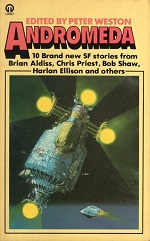|  
 
 
 
 | | | | 

| | “An Infinite Summer”
by Christopher Priest
First publication: Andromeda, May 1976

 For purposes that only they can know, people from the future—Thomas Lloyd calls them “freezers”—put a small number of people into a kind of suspended animation. Nobody can see the frozen except for those who have been previously frozen and then thawed. Thomas himself is among this select group: frozen in 1903 on the verge of proposing to his beloved Sarah; unfrozen shortly before World War II, at which point he can but view his still-frozen Sarah. For purposes that only they can know, people from the future—Thomas Lloyd calls them “freezers”—put a small number of people into a kind of suspended animation. Nobody can see the frozen except for those who have been previously frozen and then thawed. Thomas himself is among this select group: frozen in 1903 on the verge of proposing to his beloved Sarah; unfrozen shortly before World War II, at which point he can but view his still-frozen Sarah. Thomas James Lloyd, straw hat raised in his left hand, his other hand reaching out. His right knee was slightly bent, as if he were about to kneel, and his face was full of happiness and expectation. A breeze seemed to be ruffling his hair, for three strands stood on end, but these had been dislodged when he removed his hat. A tiny winged insect, which had settled on his lapel, was frozen in its moment of flight, an instinct to escape too late. Thomas James Lloyd, straw hat raised in his left hand, his other hand reaching out. His right knee was slightly bent, as if he were about to kneel, and his face was full of happiness and expectation. A breeze seemed to be ruffling his hair, for three strands stood on end, but these had been dislodged when he removed his hat. A tiny winged insect, which had settled on his lapel, was frozen in its moment of flight, an instinct to escape too late. 
| |
| | | | |

 
 
No Time Travel. Move along. |
The Nonsuch Lure by Mary Luke, 1976 [reincarnation ]

Dragonriders of Pern #3 (Harper Hall #1): Dragonsong by Anne McCaffrey, Mar 1976 [no time travel ]

“I See You” by Damon Knight, F↦SF, Nov 1976 [viewing the past ]

| |     |